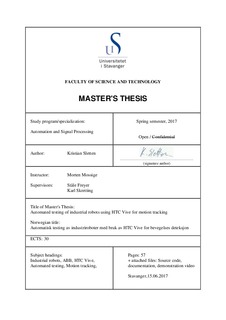| dc.description.abstract | Producers of industrial robots are continuously maintaining and upgrading their software
that is running on their robot controllers, to improve and expand the functionalities.
Extensive testing is performed to verify that all new and existing features are working
as intended before this software can be released. These tests are time consuming and
requires an operator to perform, observe, and inspect the results. A failure during these
tests can result in very time-consuming troubleshooting, as the error might be caused by
changes done several months earlier.
This project has developed a base for automating these tests to reduce the duration of
performing the tests. Further, these tests have been designed to be performed at a daily
basis, continuously testing the new software while its being developed. These tests will
give an early indication of errors that can be recti ed at a much earlier stage than during
the nal tests.
To be able to verify the robot's operations, an external system that can track the robot's
motion is required. There are existing systems that can perform this, but they have
limited functionalities and often have a very high price, making them undesirable. This
project has been challenged with using the virtual reality system HTC Vive, which have
shown promising results on its precision on tracking its devices in a three-dimensional
space, which have been veri ed through this project.
This equipment has been used to create a tracker API that uses the HTC Vive as a motion
tracking device, and tracks the robot's motion. The tracker captures the robot's path and
the tests use this to verify correct operation of the robot's controller software.
The solution in this project have shown that some of the existing tests can be automated,
but there are limitations to the HTC Vive that does not give good enough tracking to
verify all operations. The solution does however work well on several aspects concerning
continuous testing, and will work as a good tool for testing the current state of the
development, and give an early warning of failures or errors that might be introduced.
The solution has room for further implementations, and there are several more tests that
can be created to further improve the testing capabilities. | nb_NO |
